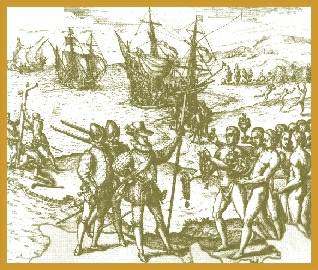|
PinkMonkey Online Study Guide-World History
Portuguese merchants also succeeded in obtaining possession of Ceylon, Sumatra, Java and the Spice Islands. However the Arabs challenged the advent of the Portuguese in the Indian Ocean. However in 1509, Francisco Da Almeida destroyed combined fleets of the Arabs and the Sultans of Egypt and Gujerat. In 1510, Goa was conquered by the Portuguese, who made it the capital of their Eastern Empire. The Portuguese were able to go to China in 1517 and to Japan in 1542.
The Atlantic Route

Exhibit 3.2
An artistís representation of Columbusí landing in the Americas
Christopher Columbus, an Italian sailor
from Genoa, felt that the Far East could be reached faster and more
easily, by sailing west across the ocean. With the aid of Queen
Isabella of Spain, Columbus set off in 1492, with 88 men on three
tiny ships, the Santa Maria, the Pinta and the Nina.
He landed on one of the Bahamas, thousands of miles from India and
China. Believing that he had landed in the East Indies he called
the natives íIndiansí. He made further voyages in 1493, 1498 and
1502, exploring the coasts of the Caribbean Sea, Venezuela and Central
America.
In 1497, King Henry VII of England employed John Cabot,
another Italian from Genoa, to sail westward. He succeeded in crossing
the Atlantic from Bristol to Cape Breton Island. John Cabotís son
Sebastian may have accompanied him on his voyage, and he may have
made a voyage to North America in 1498.
In 1500, Cabral was sailing down the African coast, in command of a Portuguese fleet when strong winds carried his ship to the coast of South America. This region came to be known as Brazil.
In 1513, a Spanish sailor, Balboa crossed the Isthmus of Panama. In 1519, Hernando Cortez discovered Mexico, and a few years later, Pizarro reached Peru.
Amerigo Vespucci of Florence conducted
several voyages around this period, and wrote some letters about
the "New World" that he claimed to have discovered. Since, his story
was the first to be printed, Waldseemuller, the German geographer,
called the "new world" - America, after Amerigo, in the new edition
of Ptolemyís Geography.
The Southwest Route
Ferdinand Magellan sailed from Spain in
1519 and crossed the Atlantic in southwesterly direction. He passed
through the straits, bearing his name, near the southern end of
South America and then crossed the broad Pacific Ocean. Though the
natives of the Philippine Islands killed Magellan, one of his ships
was able to go around Africa and thus back to Europe. This is regarded
as one of the greatest voyages in history as it was the first voyage
around the world.
The Northwest Route
English and French explorers attempted to find out a Northwest and Northeast route to the East. Jacques Cartier, a Frenchman carried out explorations in North America between 1534 and 1541 and found the mouth of the St. Lawrence River. The French King Francis I (1515-1547) was helped by Giovanni De Verrazano, Samuel De Champlain, Robert Chevalier De La Salle, Louis Joliet and Jacques Marquette in extending French colonies to Canada and the Mississippi Valley.
Englishmen such as Martin Frobisher, Gilbert, Henry Hudson, John Davis, and William Baffin were successful in exploring Newfoundland and Canada.
Hence, though a Northwest sea route to the east did not exist, the explorers were successful in discovering new lands which were of help for trade as well as colonization in the 17th century.
The Northeast Route
A supposed route to the east across the coast of North Russia, that is the Northeast Route, does not exist. However Willoughby and others made attempts to trace such a route. Thus they were successful in exploring the North coast of Russia.
By the middle of the 16th century the New World was exposed to the European countries and contact was established at several points.
[next
page]
|
Index
3.0
Introduction
3.1 Importance of Geographical
Discoveries
3.2 Causes of Geographical Discoveries
3.3 Early Travelers to the Far East
3.4 Important Geographical Discoveries
3.5 The Consequences of the Discoveries
3.6 Dates & Events
3.7 Points to Remember
Chapter
4
|